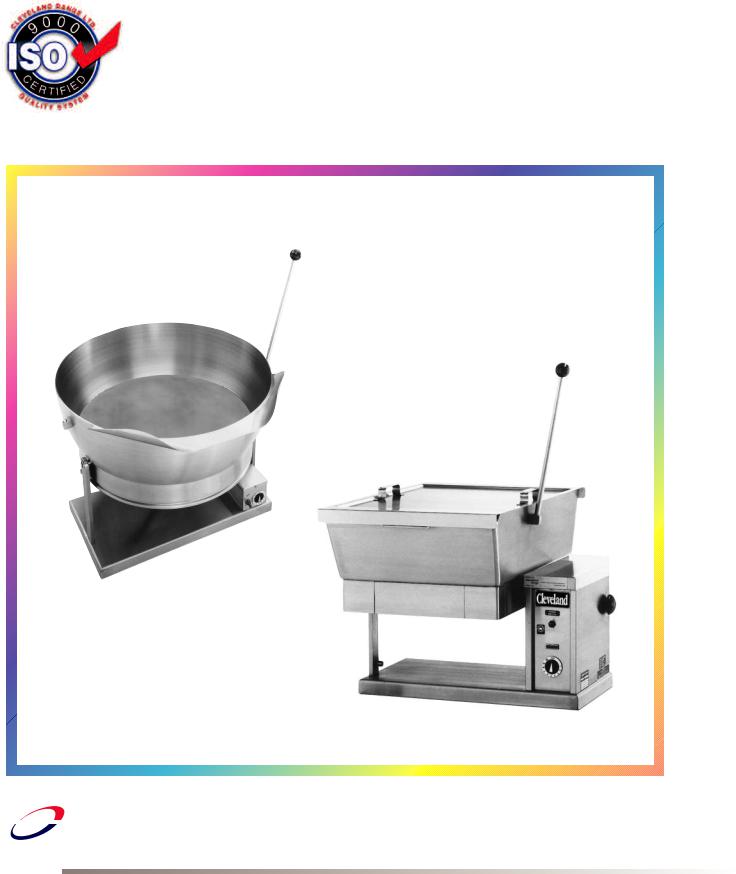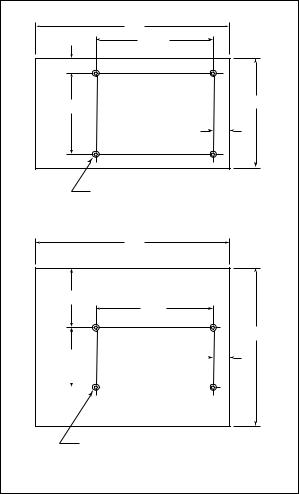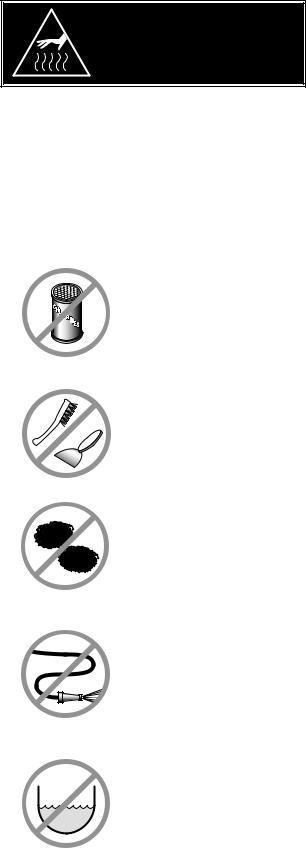Cleveland Range SET-15, SET-10 User Manual

Operators Manual
Installation, Operation & Service
Skillets
TABLE TOP ELECTRIC
SKILLETS-
MODELS:
SET-10 SET-15
SET-15
SET-10
|
™ |
|
Cleveland |
1333 East 179th St., Cleveland, Ohio, U.S.A. 44110 |
|
|
|
|
|
Enodis |
Phone: (216) 481-4900 Fax: (216) 481-3782 |
|
|
Visit our web site at www.clevelandrange.com |
|
|
SE95031 rev. 4 |

FOR THE USER
WARNING:
Improper installation, adjustment, alteration, service or maintenance ! can cause property damage, injury or death.
Read the Installation and Operating instructions thoroughly before installing or servicing this equipment.
IMPORTANT
THE INSTALLATION AND CONNECTION MUST COMPLY WITH THE LOCAL AND NATIONAL ELECTRICAL CODES.
ENSURE ELECTRICAL SUPPLY CONFORMS WITH ELECTRICAL CHARACTERISTICS
SHOWN ON THE RATING LABEL
ALL SERVICE MUST BE PERFORMED BY A QUALIFIED CLEVELAND RANGE TECHNICIAN.
RETAIN THIS MANUAL FOR YOUR REFERENCE.
INSTALLATION
GENERAL INFORMATION
These instructions must be retained by the owner/user for future reference.
The serial plate is located on the right side of the control housing. Voltage, phase, amperage and wattage are stated on the plate.
This equipment is built to comply with applicable standards for manufacturers. Included among those approval agencies are: UL, NSF, CSA, ETL, and others. Many local codes exist, and it is the responsibility of the owner and installer to comply with these codes.
GENERAL INSTALLATION
Check the electrical rating label to ensure that the unit is the correct voltage, phase, amperage and wattage are stated on this label.
Observe all clearance requirements to provide air supply for proper operation, as well as sufficient clearance for servicing. Keep the skillet area free and clear of combustibles. Dimensions and clearance specifications are shown on the specification sheet.
WARNING: Installation of skillet must be accomplished by qualified installation personnel, working to all applicable local and national codes. Improper installation of product could cause injury or damage, and void the warranty.
Installation must be in accordance with local codes and/or the National Electric Code ANSI/NFPA No. 70latest edition (USA) or the Canadian Electrical Code CSA Standard C22.1 (Canada). The skillet must be electrically grounded by the installer.
Electrically powered skillets require a separate fused disconnect switch which must be supplied and installed in the high voltage electrical supply line. The wire gauge size and electric supply must match the power requirements specified on the skillet's rating plate. The conduit-enclosed permanent copper wiring must be adequate to carry the required current at rated voltage. Refer to the specification sheet for electrical specifications and location of electrical connections.
INSPECTION / UNPACKING
1.Before unpacking visually inspect the unit for evidence of damage during shipping.
2.If damage is noticed, do not unpack the unit, follow "SHIPPING DAMAGE INSTRUCTIONS" shown below.
3.Carefully remove unit from shipping carton. Remove any packing material from unit. After carefully unpacking check for "concealed" damage. If damage is noticed, follow "SHIPPING DAMAGE INSTRUCTIONS" shown below.
4.Check the electrical rating label to ensure that the unit is the correct voltage, phase, amperage and wattage are stated on this label.
5.A protective material has been applied to the stainless steel panels. This material must be removed immediately after installation, as heat will melt the material and make it more difficult to remove.
SHIPPING DAMAGE
INSTRUCTIONS
If shipping damage to the unit is discovered or suspected, observe the following guidelines in preparing a shipping damage claim.
1.Write down a description of the damage or the reason for suspecting damage as soon as it is discovered. This will help in filling out the claim forms later.
2.As soon as damage is discovered or suspected, notify the carrier that deliveredthe shipment.
3.Arrange for the carrier's representative to examine the damage.
4.Fill out all carrier claims forms and have the examining carrier sign and date each form.

INSTALLATION CLEARANCES
This unit must be installed in accordance with the following clearances in order to provide proper operation and servicing of the appliance. Also, it is recommended the unit be installed with sufficient clearances to provide proper cleaning and maintenance.
Clearances -
SET-10 - RIGHT: 3”, LEFT: 0”, REAR 1”
SET-15 - RIGHT: 4”, LEFT: 4”, REAR 1/2”
INSTALLATION
1.Carefully remove unit from carton or crate. Remove any packing material from unit. On stainless steel panels, the protective material should be removed before the unit is installed.
2.Set skillet in position where electrical services are nearby. Comply with clearances stated on the specification sheet. Ensure there is sufficient clearance between skillet and back wall.
3.Table-top models must be positioned on a firm, level stand or existing counter top, and bolted in place, using the four 5/16"-18 rods and nuts included with the skillet. These models are supplied with four 5/16"-18 weldnuts welded to underside of the base.
|
24” |
|
14 1/2” |
1 3/8” |
|
10” |
12 1/2” |
|
|
|
2 1/6” |
FOUR 5/16”-18 THREADED FERRULES
WELDED TO UNDERSIDE OF BASE
SET-10 MOUNTING DIAGRAM
24”
7 3/8”
14 1/2”
19 1/2”
7 3/8” |
|
1 1/16” |
|
|
||
|
|
|||||
|
|
|
|
|
|
|
|
|
|
|
|
|
|
FOUR 5/16”-18 THREADED FERRULES
WELDED TO UNDERSIDE OF BASE
SET-15 MOUNTING DIAGRAM
Make four 3/8" holes in an existing stand or countertop, in order to secure the base of the skillet. Once the holes are made, screw the threaded rods into the ferrules on the bottom of the skillet base. Then insert the threaded rods through the holes on the stand or countertop. Thread the nuts onto the threaded rod and tighten to secure base. Once secure and level, apply a seal of silicon, to the entire edge of the base at the countertop. This will prevent food particles from entering underneath the skillet base. Screw the tilt handle into the threaded mounting block welded to the side of the skillet.
ELECTRICAL CONNECTION
SET-10: Remove the screw at the rear of the console cover, and remove the cover. A wiring diagram is affixed to the underside of the cover. Feed conduit enclosed permanent copper wiring through the cut-out in the rear of the console, and fasten to the three connection terminal block. Be sure to connect the ground wire to the separate ground terminal connector (ground lug). Replace the console cover and secure it with the screw.
SET-15: Remove the two screws securing the console cover, and remove the cover. A wiring diagram is affixed to the underside of the cover. Feed conduit enclosed permanent copper wiring through the cut-out in the rear of the console, and fasten to the pigtail leads fastened to the single contactor. Be sure to connect the ground wire to the separate ground terminal connector (ground lug). Replace the console cover and secure it with the screws.
INSTALLATION CHECK
Although the skillet has been thoroughly tested before leaving the factory, the installer is responsible for ensuring the proper operation of the skillet once installed.
1.Ensure that electric supply to the skillet is turned on.
2.Remove the lift-off cover.
3.Place the skillet's power on/off switch to the "on" position.
4.Dial the thermostat switch to the maximum setting. The indicator light near the thermostat switch should be illuminated until the set temperature is reached, then cycle on and off as the thermostat cycles on and off to maintain the set temperature.
5.Pour 2 gallons (8 liters) of cool tap water into preheated skillet pan.
6.It should take approximately 3 minutes for the water to begin to simmer. Shortly, the water should be bubbling uniformly across the entire cooking surface.
7.Dial the thermostat switch back to the "off" position.
8.Tilt skillet to drain the water out of the skillet pan, into an appropriate pan or other container.
9.Lower the skillet, place the power on/off switch to the "off' position.
OPERATING INSTRUCTIONS
1.Ensure that the electrical supply to the skillet is turned on.
2.Before cooking, be sure that the skillet's cooking surface is clean, and that the skillet is in the fully lowered position.
3.Place the skillet's power on/off switch to the "on" position.
4.Pre-heat skillet for approximately 10 minutes by turning the temperature control knob to the desired temperature setting (see TEMPERATURE APPLICATION CHART). The indicator light will remain lit, indicating the heater elements are activated, until the temperature setting has been reached. When the indicator light goes off, heaters are off, and preheating is complete.
NOTE: When cooking egg and milk products, the skillet should not be preheated, as products of this nature adhere to hot cooking surfaces. These types of foods should be placed in the skillet before heating is begun.
5.Place the food product into the skillet, distributing it evenly across the cooking surface. The indicator light will cycle on and off indicating the elements are cycling on and off. The cover should be off for most types of cooking or simmering. If cover is on, the vent cap can be used to reduce water content in product or allow steam to escape before lifting cover.
6.Pour the contents of the skillet into an appropriate container by tilting the skillet forward. Care should be taken to pour slowly enough to avoid splashing of the product.
NOTE: As with cleaning food soil from any cookware, and important part of skillet cleaning is to prevent foods from drying on. For this reason, cleaning should be completed immediately after cooked foods are removed. Refer to the "Cleaning Instructions" Instructions for detailed skillet washing procedures.
TEMPERATURE APPLICATION CHART
|
Approximate |
|
|
Dial Temperature |
|
|
|
|
Application |
°F |
°C |
|
|
|
Bain Marie |
150-200 65-93 |
|
|
|
|
Slow Cooking |
225 |
107 |
|
|
|
Braise |
250-275 121-135 |
|
|
|
|
Sauce Pan, Low Griddle |
325 |
163 |
|
|
|
Med. Griddle, Sauté, Steam |
350 |
177 |
|
|
|
Hot Griddle |
375 |
191 |
|
|
|
Fry, Shallow Oil |
400-425 |
204-218 |
|
|
|

CLEANING INSTRUCTIONS
CAUTION
SURFACES MAY
BE EXTREMELY HOT!
CARE AND CLEANING
Cooking equipment must be cleaned regularly to maintain its fast, efficient cooking performance and to ensure its continued safe, reliable operation. The best time to clean is shortly after each use (allow unit to cool to a safe temperature).
WARNINGS
|
Do not use detergents or |
|
cleansers that are chloride |
|
based or contain quaternary |
|
salt. |
|
Chloride Cleaners |
|
Do not use a metal bristle |
|
brush or scraper. |
|
Wire Brush & |
|
Steel wool should never be |
|
used for cleaning the stainless |
|
steel. |
CLEANING INSTRUCTIONS
1.Turn unit off.
2.Prepare a warm water and mild detergent solution in the unit.
3.Remove food soil using a nylon brush.
4.Loosen food which is stuck by allowing it to soak at a low temperature setting.
5.Drain unit.
6.Rinse interior thoroughly.
NOTES
For more difficult cleaning applications one of the following can be used: alcohol, baking soda, vinegar, or a solution of ammonia in water.
Leave the cover off when the unit is not in use.
For more detailed instructions refer to the Nafem Stainless Steel Equipment Care and Cleaning manual
|
Steel Pads |
|
Unit should never be cleaned |
|
with a high pressure spray |
|
hose. |
|
High Pressure |
|
Spray Hose |
|
Do not leave water sitting in unit |
|
when not in use. |
Stagnant
Water
STAINLESS STEEL EQUIPMENT CARE AND CLEANING
(Supplied courtesy of Nafem. For more information visit their web site at www.nafem.org)
Contrary to popular belief, stainless steels ARE susceptible to rusting. |
4. |
Treat your water. |
|
|
||
Corrosion on metals is everywhere. It is recognized quickly on iron and |
|
Though this is not always practical, softening hard water can do much |
||||
steel as unsightly yellow/orange rust. Such metals are called “active” |
|
to reduce deposits. There are certain filters that can be installed to |
||||
because they actively corrode in a natural environment when their atoms |
|
remove distasteful and corrosive elements. To insure proper water |
||||
combine with oxygen to form rust. |
|
treatment, call a treatment specialist. |
|
|||
Stainless steels are passive metals because they contain other metals, like |
5. |
Keep your food equipment clean. |
|
|||
chromium, nickel and manganese that stabilize the atoms. 400 series |
|
Use alkaline, alkaline chlorinated or non-chloride cleaners at |
||||
stainless steels are called ferritic, contain chromium, and are magnetic; |
|
|||||
|
recommended strength. Clean frequently to avoid build-up of hard, |
|||||
300 series stainless steels are called austenitic, contain chromium and |
|
|||||
|
stubborn stains. If you boil water in stainless steel equipment, |
|||||
nickel; and 200 series stainless, also austenitic, contains manganese, |
|
|||||
|
remember the single most likely cause of damage is chlorides in the |
|||||
nitrogen and carbon. Austenitic types of stainless are not magnetic, and |
|
|||||
|
water. Heating cleaners that contain chlorides have a similar effect. |
|||||
generally provide greater resistance to corrosion than ferritic types. |
|
|||||
6. |
Rinse, rinse, rinse. |
|
|
|||
With 12-30 percent chromium, an invisible passive film covers the steel’s |
|
|
||||
|
If chlorinated cleaners are used, rinse and wipe equipment and |
|||||
surface acting as a shield against corrosion. As long as the film is intact |
|
|||||
and not broken or contaminated, the metal is passive and stain-less. If the |
|
supplies dry immediately. The sooner you wipe off standing water, |
||||
passive film of stainless steel has been broken, equipment starts to |
|
especially when it contains cleaning agents, the better. After wiping |
||||
corrode. At its end, it rusts. |
|
equipment down, allow it to air dry; oxygen helps maintain the |
||||
Enemies of Stainless Steel |
|
stainless steel’s passivity film. |
|
|||
7. |
Never use hydrochloric acid (muriatic acid) on stainless steel. |
|||||
There are three basic things which can break down stainless steel’s |
||||||
8. |
Regularly restore/passivate stainless steel. |
|||||
passivity layer and allow corrosion to occur. |
||||||
1. |
Mechanical abrasion |
|
|
|
|
|
2. |
Deposits and water |
Recommended cleaners for specific situations |
||||
3. |
Chlorides |
Job |
|
Cleaning Agent |
Comments |
|
Mechanical abrasion means those things that will scratch a steel surface. |
Routine cleaning |
Soap, ammonia, |
Apply with cloth or sponge |
|||
|
|
detergent, Medallion |
|
|||
Steel pads, wire brushes and scrapers are prime examples. |
|
|
|
|||
|
|
|
|
|||
Fingerprints & smears |
Arcal 20, Lac-O-Nu |
Provides barrier film |
||||
Water comes out of the faucet in varying degrees of hardness. Depending |
||||||
|
|
Ecoshine |
|
|||
on what part of the country you live in, you may have hard or soft water. |
|
|
|
|
||
Stubborn stains & |
Cameo, Talc, Zud, |
Rub in direction of polish lines |
||||
Hard water may leave spots, and when heated leave deposits behind that |
||||||
discoloration |
First Impression |
|
||||
if left to sit, will break down the passive layer and rust stainless steel. Other |
|
|
|
|
||
Grease & fatty acids, |
Easy-off, De-Grease |
Excellent removal on all finishes |
||||
deposits from food preparation and service must be properly removed. |
||||||
blood, burnt-on-foods |
It Oven Aid |
|
||||
Chlorides are found nearly everywhere. They are in water, food and table |
|
|
|
|||
Grease & oil |
Any good |
Apply with sponge or cloth |
||||
salt. One of the worst chloride perpetrators can come from household and |
|
|
commercial detergent |
|
||
industrial cleaners. |
Restoration/Passivation |
Benefit, Super Sheen |
|
|||
So what does all this mean? Don’t Despair! |
|
|
|
|
||
Review |
|
|
||||
Here are a few steps that can help prevent stainless steel rust. |
|
|
||||
1. |
Stainless steels rust when passivity (film-shield) breaks down as a |
|||||
1. Use the proper tools. |
||||||
|
result of scrapes, scratches, deposits and chlorides. |
|||||
|
|
|
||||
|
When cleaning stainless steel products, use non-abrasive tools. Soft |
2. |
Stainless steel rust starts with pits and cracks. |
|||
|
cloths and plastic scouring pads will not harm steel’s passive layer. |
|||||
|
3. |
Use the proper tools. Do not use steel pads, wire brushes or scrapers |
||||
|
Stainless steel pads also can be used but the scrubbing motion must |
|||||
|
be in the direction of the manufacturers’ polishing marks. |
|
to clean stainless steel. |
|
||
2. |
Clean with the polish lines. |
4. |
Use non-chlorinated cleaners at recommended concentrations. Use |
|||
|
Some stainless steel comes with visible polishing lines or “grain.” |
|
only chloridefree cleaners. |
|
||
|
5. |
Soften your water. Use filters and softeners whenever possible. |
||||
|
When visible lines are present, always scrub in a motion parallel to the |
|||||
|
lines. When the grain cannot be seen, play it safe and use a soft cloth |
6. |
Wipe off cleaning agent(s) and standing water as soon as possible. |
|||
|
or plastic scouring pad. |
|
Prolonged contact causes eventual problems. |
|||
3. Use alkaline, alkaline chlorinated or non-chloride containing cleaners.
While many traditional cleaners are loaded with chlorides, the industry is providing an ever-increasing choice of non-chloride cleaners. If you are not sure of chloride content in the cleaner used, contact your cleaner supplier. If your present cleaner contains chlorides, ask your supplier if they have an alternative. Avoid cleaners containing quaternary salts; it also can attack stainless steel and cause pitting and rusting.
To learn more about chloride-stress corrosion and how to prevent it, contact the equipment manufacturer or cleaning materials supplier.
Developed by Packer Engineering, Naperville, Ill., an independent testing laboratory.

SERVICE PARTS
WARRANTY
Our Company supports a worldwide network of Maintenance and Repair Centers. Contact your nearest Maintenance and Repair Centre for replacement parts, service, or information regarding the proper maintenance and repair of your cooking equipment
In order to preserve the various agency safety certification (UL, NSF, ASME/Ntl. Bd., etc.), only factorysupplied replacement parts should be used. The use of other than factory supplied replacement parts will void warranty.
FAUCET ASSEMBLY,SET-10 & SET-15
ITEM PART DESCRIPTION QTY.
NO. NO.
A |
SPK15 |
Single Pantry Faucet Kit for SET-10 |
|
|
DPK15 |
Double Pantry Faucet Kit for SET-10 |
|
|
|
(Includes items 1-10) . . . . . . . . . . . . . |
1 |
B |
SPK16 |
Single Pantry Faucet Kit for SET-15 |
|
|
DPK16 |
Double Pantry Faucet Kit for SET-15 |
|
|
|
(Includes items 1-10) . . . . . . . . . . . . . |
1 |
|
|
Bracket Kit (includes #3, 8, 9 & 10) |
|
|
FBS-SET15T |
for SET-15 . . . . . . . . . . . . . . . . . . . . . |
1 |
|
FBS-SET10T |
for SET-10 . . . . . . . . . . . . . . . . . . . . . |
1 |
1. |
KE50825-6 |
3/4" Spout . . . . . . . . . . . . . . . . . . . . . . |
1 |
2. |
KE51401 |
Single Pantry Body . . . . . . . . . . . . . . |
1 |
|
KE51403 |
Double Pantry Body . . . . . . . . . . . . . . |
1 |
3. |
SK2302200 |
Bracket for SET-15 . . . . . . . . . . . . . . |
1 |
|
SK2308800 |
Bracket for SET-10 . . . . . . . . . . . . . . |
1 |
4. |
FA05007-10 |
"C" Clip . . . . . . . . . . . . . . . . . . . . . . . . |
1 |
5. |
FA05002-19 |
"O" Ring . . . . . . . . . . . . . . . . . . . . . . . |
1 |
6. |
KE51736 |
Faucet Nut . . . . . . . . . . . . . . . . . . . . . |
1 |
7.KE50335 Adapter Washer (Single Pantry only) . . 1
8. |
FA21008 |
Hex Nut . . . . . . . . . . . . . . . . . . . . . . . |
2 |
9. |
FA11260 |
Bolt for SET-15 . . . . . . . . . . . . . . . . . . |
2 |
|
FA11258 |
Bolt for SET-10 . . . . . . . . . . . . . . . . . . |
2 |
10. |
FA31029 |
Lock Washer . . . . . . . . . . . . . . . . . . . |
.2 |
1
4 
1 |
5 |
|
|
4 |
6 |
5 

2
6
B
A
7
2
7
3
2
9
3 |
2 |
10
8
 9 10
9 10
8
